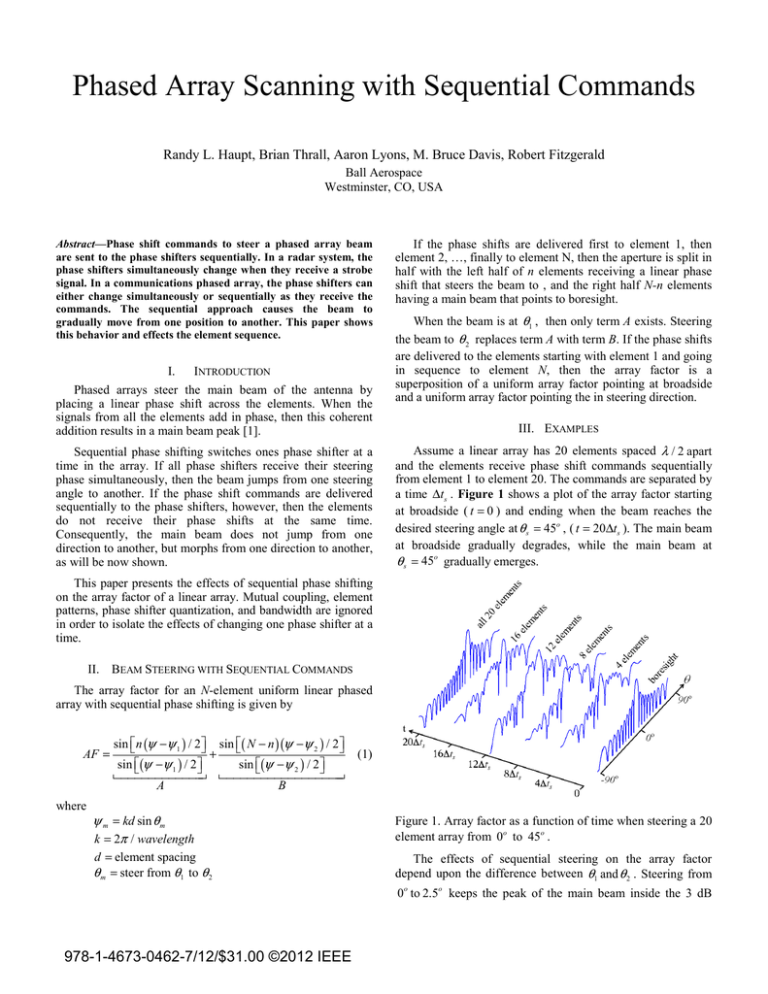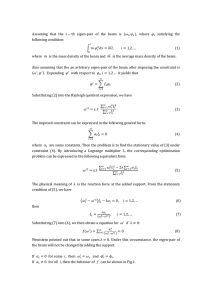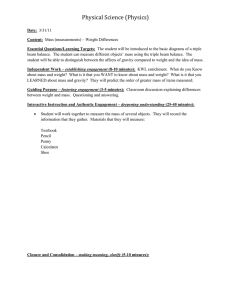Phased Array Scanning with Sequential Commands
advertisement

Phased Array Scanning with Sequential Commands Randy L. Haupt, Brian Thrall, Aaron Lyons, M. Bruce Davis, Robert Fitzgerald Ball Aerospace Westminster, CO, USA Abstract—Phase shift commands to steer a phased array beam are sent to the phase shifters sequentially. In a radar system, the phase shifters simultaneously change when they receive a strobe signal. In a communications phased array, the phase shifters can either change simultaneously or sequentially as they receive the commands. The sequential approach causes the beam to gradually move from one position to another. This paper shows this behavior and effects the element sequence. I. INTRODUCTION Phased arrays steer the main beam of the antenna by placing a linear phase shift across the elements. When the signals from all the elements add in phase, then this coherent addition results in a main beam peak [1]. Sequential phase shifting switches ones phase shifter at a time in the array. If all phase shifters receive their steering phase simultaneously, then the beam jumps from one steering angle to another. If the phase shift commands are delivered sequentially to the phase shifters, however, then the elements do not receive their phase shifts at the same time. Consequently, the main beam does not jump from one direction to another, but morphs from one direction to another, as will be now shown. If the phase shifts are delivered first to element 1, then element 2, …, finally to element N, then the aperture is split in half with the left half of n elements receiving a linear phase shift that steers the beam to , and the right half N-n elements having a main beam that points to boresight. When the beam is at θ1 , then only term A exists. Steering the beam to θ 2 replaces term A with term B. If the phase shifts are delivered to the elements starting with element 1 and going in sequence to element N, then the array factor is a superposition of a uniform array factor pointing at broadside and a uniform array factor pointing the in steering direction. III. EXAMPLES Assume a linear array has 20 elements spaced λ / 2 apart and the elements receive phase shift commands sequentially from element 1 to element 20. The commands are separated by a time Δts . Figure 1 shows a plot of the array factor starting at broadside ( t = 0 ) and ending when the beam reaches the desired steering angle at θ s = 45o , ( t = 20Δt s ). The main beam at broadside gradually degrades, while the main beam at θ s = 45o gradually emerges. This paper presents the effects of sequential phase shifting on the array factor of a linear array. Mutual coupling, element patterns, phase shifter quantization, and bandwidth are ignored in order to isolate the effects of changing one phase shifter at a time. II. BEAM STEERING WITH SEQUENTIAL COMMANDS The array factor for an N-element uniform linear phased array with sequential phase shifting is given by AF = where sin ⎣⎡ n (ψ −ψ 1 ) / 2⎦⎤ + sin ⎣⎡( N − n )(ψ −ψ 2 ) / 2 ⎦⎤ sin ⎡⎣(ψ −ψ 1 ) / 2 ⎤⎦ sin ⎡⎣(ψ −ψ 2 ) / 2 ⎤⎦ A B (1) ψ m = kd sin θ m k = 2π / wavelength Figure 1. Array factor as a function of time when steering a 20 element array from 0o to 45o . d = element spacing The effects of sequential steering on the array factor depend upon the difference between θ1 and θ 2 . Steering from θ m = steer from θ1 to θ 2 0o to 2.5o keeps the peak of the main beam inside the 3 dB 978-1-4673-0462-7/12/$31.00 ©2012 IEEE beamwidth of the broadside beam. Figure 2 is a plot of the array factor after each phase shifter receives its steering command. The broadside beam moves in the negative θ direction while the new main beam at 2.5o begins to emerge. The main beam at 0o eventually disappears leaving the main beam at 2.5o . Figure 3 is a plot of the maximum directivity and its location in θ as the beam is steered. This plot confirms that the main beam starts moving in the negative θ direction before moving to its final destination. Along the way, the peak directivity decreases by 3 dB. ordering of the phase shift commands. The beam wandering is reduced at the expense of loss in directivity. Figure 4. Location of main beam peak as a function of time. Figure 2. Array factor as a function of time. Figure 5. Location of main beam peak vs. angle as a function of time when the element ordering is optimized. IV. CONCLUSIONS Figure 3. Location of main beam peak vs. angle as a function of time. Increasing the beam steering to θ s = 5.5o puts the steered beam at the peak of the first sidelobe of the broadside pattern.Error! Reference source not found. Figure 4 is a plot of the maximum directivity and its location in θ as the beam scans. The maximum directivity shifts from θ = 0o to θ = −1o at the same time the directivity decreases before main beam maximum jumps. It then slowly gains directivity as it moves to the desired steering angle. The beam wandering can be reduced by either randomizing the order of the elements that receive the phase shifts or optimizing the order. Figure 5 results from an optimized The main beam of a phased array can be scanned by sending the phase shifts to all the phase shifters, then changing their phase simultaneously, or by sending the phase shifts one at a time and changing the phase whenever the phase shifter receives the command. A sequential phase shift, however, results in the main beam traveling a path from its present position to its desired new position with accompanying sidelobe level distortions. The beam wandering can be minimized by sending the phase steering commands in a random or optimal non-sequential order. REFERENCES [1] R. L Haupt, Antenna Arrays: A Computational Approach, New York, Wiley, 2010.








